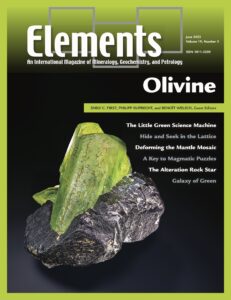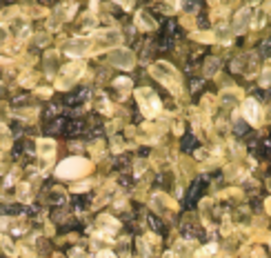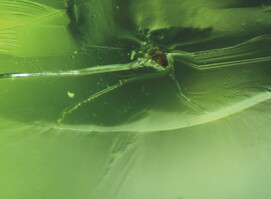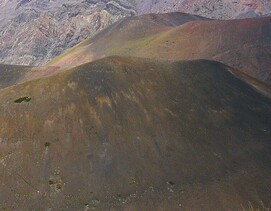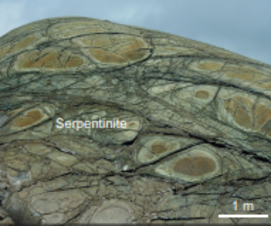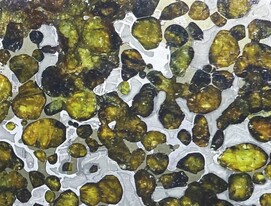Olivine
Emily C. First, Philipp Ruprecht, and Benoit Welsch – Guest Editors
Table of Contents
To study the Earth and other planetary bodies, one has to understand the mineral olivine; when and where it forms, how it crystallizes and deforms, and how it responds to changing environmental conditions in the Earth’s interior, on the surface, and in space. This issue will take a look at olivine research from the atomic scale to the Solar System and beyond. Olivine plays a critical role for plate tectonics, magma transport from mantle sources to the surface, how the Solar System differentiated and evolved, and also for the efforts addressing climate change through carbon capture and storage. This issue will highlight olivine research that crosses many disciplines, from seismology and geodynamics, petrology and volcanology to low-temperature geochemistry and remote sensing.
- Olivine—The Little Green Science Machine
- Hide and Seek—Trace Element Incorporation and Diffusion in Olivine
- Deforming the Upper Mantle—Olivine Mechanical Properties and Anisotropy
- Olivine Exit Interviews—Piecing Together Magmatic Puzzles
- Olivine—The Alteration Rock Star
- Galaxy of Green
Gemological Society of America
v19n4 Biomagnetism
Guest Editors: James Byrne (University of Bristol, UK) and Matthieu Amor (École Normale Supérieure de Lyon, France)
In this thematic issue of Elements, we look into biomagnetism and the production of magnetic minerals by microorganisms. In popular culture, this may have supernatural connotations; however, in reality, there are many microscopic biological organisms possessing magnetic behaviour owing to their formation of magnetic nanoparticles (MNP) such as magnetite (Fe3O4), maghemite (γ-Fe2O3), and greigite (Fe3S4). We look broadly at the relationship between biogenic MNP formation and biomagnetism: focusing on the mechanisms responsible for these minerals by bacteria; seeking to address whether MNP hold clues to the evolution of life on Earth, and potentially beyond; investigating the contribution of biomagnetism to the biogeochemical cycling of iron; considering the potential application of MNP for industrial remediation; and probing the presence of MNP in multicellular prokaryotes and eukaryotic organisms.
- Biomagnetism: Insights into Magnetic Minerals Produced by Biological Microorganisms James M. Byrne (University of Bristol, UK) and Matthieu Amor (École Normale Supérieure de Lyon, France)
- Magnetofossils: Relicts and Records of Deep Time and Space Sarah P. Slotznick (Dartmouth College, USA), Ramon Egli (Zentralanstalt für Meteorologie und GeodynamikAustria), and Ioan Lascu (National Museum of Natural History, Smithsonian Institution, USA)
- Impact of Biogenic Magnetite Formation and Transformation on Biogeochemical Cycles Andreas Kappler (University of Tübingen, Germany), Aaron Thompson (University of Georgia, USA), and Muammar Mansor (University of Tübingen, Germany)
- Environmental, Biomedical, and Industrial Applications of Biogenic Magnetite Nanoparticles Lucía Gandarias (Universidad del País Vasco, Spain), Richard L. Kimber (University of Vienna, Austria), and Georges Ona-Nguema (Sorbonne Université, France)
- Magnetosomes and Magnetic Orientation in Multicellular Prokaryotes and Eukaryotes Pedro Leão (University of Texas at Austin, USA) and Christopher Lefevre (Aix-Marseille Université, France)
- Alkaline Lakes (February 2023)
- Into the Rift: The Geology of Human Origins in Eastern Africa (April 2023)
- Olivine (June 2023)
- Biomagnetism (August 2023)
- Large Igneous Provinces: Versatile Drivers of Global Change (October 2023)
- Geometallurgy (December 2023)



